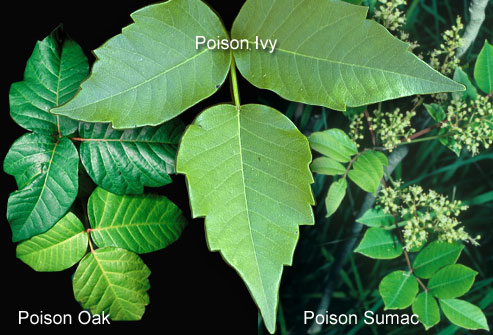Poison Ivy
The plant’s 3-leaf trademark mentioned earlier assumes a reddish tinge when the leaves first come out in the spring, but the leaves turn green in the summer. Although the color of its berries is often mentioned as a way of identifying the plant, it is not as reliable as is leaf identification. The berries, after all, are produced only at the end of the growing season; knowing about the berries would do you little good when attempting identification in the spring. Incidentally, poison ivy, poison oak, and poison sumac all have white berries. The non-poisonous varieties of sumac have red berries.
But if you’re reading this post while plagued with the itching that the plant brings, you’ll be much more interested in hearing some treatment tips and the quickest way getting back to life as you normally live it! (I can still remember my first adventure with poison Ivy on a fishing trip with my dad at the age of 6 years old, but of course, my dad convinced me it was worth it since we caught all those fish!)
 Is Poison Ivy Rash Contagious?
Is Poison Ivy Rash Contagious?
Now that we’ve identified poison ivy on let’s consider the matter of treating poison ivy rash. When we speak of a cure or treatment for poison ivy rash, we generally mean relief from its symptoms. Once the symptoms occur (itchy bumps on your skin), relief is the only remedy we seek — before we scratch ourselves to death! Different people find different degrees of relief by treating poison ivy rash with over-the-counter remedies, such as hydrocortisone. Despite its inclusion in the classic rock song, “Poison Ivy,” even Calamine lotion has its limitations as a treatment.
Some people have such a severe reaction to poison ivy that they need to visit a physician and get a shot. It usually takes about two weeks to get rid of poison ivy rash.
But there is another kind of treatment of poison ivy rash: namely, prevention. If you realize you’ve just come into contact with poison ivy, take the following steps immediately:
So what makes poison ivy (and poison oak and poison sumac, too)…well, poisonous? The answer is urushiol, which is the sap that runs through all parts of the plant. Grazing against poison ivy with any exposed part of your body is all that it takes to release this poison. Complicating matters further, contact with poison ivy does not even have to be direct for you to contract the rash. For instance, if your dog runs through some poison ivy, then you stroke your dog’s fur with your hand; you could come into contact with the sap and develop a rash. Likewise, if someone else had been working in a poison ivy-infested area with gloves, then you came along and touched those contaminated gloves, you could get the rash.
So if the poison is spread that easily, poison ivy must be contagious, right? Wrong. It’s only the urushiol that puts you at risk. Scratching your bumps don’t cause the poison ivy to spread to other areas of your body. Nor will you contract the rash just by touching somebody else’s rash bumps.
Poison Ivy Control: Get Rid of It with Organic Methods, Herbicides
First of all, a word about prevention is in order, before discussing any actions to be taken for getting rid of poison ivy plants on the landscape. When approaching poison ivy to engage it in battle, try to have a little of your skin exposed as possible, since it is through physical contact with the plant (any part of the plant!) that the rash is contracted. At the very least, this means wearing gloves, a long-sleeved shirt, and full-length pants. Secondly, I understand that any of the methods discussed below may have to be implemented more than once to achieve complete success.
One organic method to eradicate, or at least control, poison ivy is to pull it out by the roots.
Herbicides can also be used in the control or eradication of poison ivy. Roundup spray is a popular glyphosate-based herbicide for killing poison ivy. Another widely-available herbicide is Ortho Brush-B-Gon, which is triclopyr-based. But they will kill many other plants, too, so don’t use them near plants you wish to keep. If you choose to apply these herbicides by spraying, here’s what to do:
